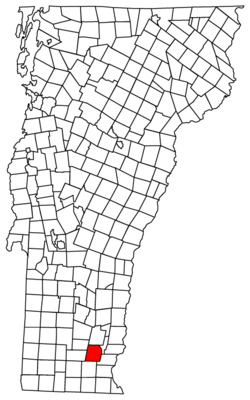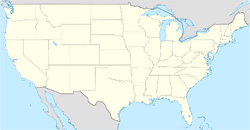| Main | Births etc |
|---|
| Newfane, Vermont | |
|---|---|
| — Town — | |
| A church in Newfane | |
| Location in Vermont. | |
| Coordinates: Coordinates: | |
| Country | United States |
| State | Vermont |
| County | Windham |
| Chartered | 1761 |
| Area | |
| • Total | 40.4 sq mi (104.6 km2) |
| • Land | 40.2 sq mi (104.2 km2) |
| • Water | 0.1 sq mi (0.4 km2) |
| Elevation | 1,004 ft (306 m) |
| Population (2000) | |
| • Total | 1,680 |
| • Density | 41.7/sq mi (16.1/km2) |
| Time zone | Eastern (EST) (UTC-5) |
| • Summer (DST) | EDT (UTC-4) |
| ZIP code | 05345 |
| Area code(s) | 802 Exchange: 365 |
| FIPS code | 50-48400[1] |
| GNIS feature ID | 1462159[2] |
Newfane is the shire town[3] (county seat)[4] of Windham County, Vermont, United States. The population was 1,680 at the 2000 census. The town includes the villages of Newfane, Williamsville and South Newfane.
History[]
One of the New Hampshire grants, it was chartered on June 19, 1753 by Governor Benning Wentworth, who named it Fane after John Fane, the 7th Earl of Westmoreland. But hostilities during the French and Indian War prevented its settlement. Because a first town meeting was not held within the required five years, the charter was deemed null and void. So Wentworth issued an entirely new charter on November 3, 1761 as New Fane. The town was settled in 1766 by families from Worcester County, Massachusetts.[5] Newfane became the shire town of the county before 1812. Atop Newfane Hill, they built a village, including the county buildings. Because of winter travel difficulties, however, it was relocated to the flatland below in 1825, until 1882 called Fayetteville after the Marquis de Lafayette.[6]
The town has a diversified terrain, with both high hills and deep valleys. Farmers found good soil for cultivation on the intervales, and for grazing livestock on the uplands. Various streams provided water power for mills, and by 1859 industries included manufacturers of both leather and linseed oil, two flour mills, two lumber mills, and a large carriage factory.[7] As a result, Newfane became prosperous during the 19th-century, when it built the Federal, Greek Revival and Victorian architecture that today makes it a favorite tourist destination.[6]
Geography[]
According to the United States Census Bureau, the town has a total area of 40.4 square miles (104.6 km2), of which 40.2 square miles (104.2 km2) is land and 0.1 square mile (0.4 km2) (0.35%) is water. The West and Rock rivers flow through the town.[8]
Newfane is crossed by Vermont Route 30.
Demographics[]
| Historical populations | |||
|---|---|---|---|
| Census | Pop. | %± | |
| 1790 | 660 | ||
| 1800 | 1,000 | 51.5% | |
| 1810 | 1,276 | 27.6% | |
| 1820 | 1,506 | 18.0% | |
| 1830 | 1,441 | −4.3% | |
| 1840 | 1,043 | −27.6% | |
| 1850 | 1,304 | 25.0% | |
| 1860 | 1,192 | −8.6% | |
| 1870 | 1,113 | −6.6% | |
| 1880 | 1,031 | −7.4% | |
| 1890 | 952 | −7.7% | |
| 1900 | 905 | −4.9% | |
| 1910 | 820 | −9.4% | |
| 1920 | 710 | −13.4% | |
| 1930 | 662 | −6.8% | |
| 1940 | 672 | 1.5% | |
| 1950 | 708 | 5.4% | |
| 1960 | 714 | 0.8% | |
| 1970 | 900 | 26.1% | |
| 1980 | 1,129 | 25.4% | |
| 1990 | 1,555 | 37.7% | |
| 2000 | 1,680 | 8.0% | |
| 2010 | 1,726 | 2.7% | |
| Est. 2014 | 1,684 | [9] | 0.2% |
| U.S. Decennial Census[10] | |||
As of the census[1] of 2000, there were 1,680 people, 693 households, and 464 families residing in the town. The population density was 41.7 people per square mile (16.1/km2). There were 977 housing units at an average density of 24.3 per square mile (9.4/km2). The racial makeup of the town was 98.10% White, 0.18% Black or African American, 0.30% Native American, 0.12% Asian, 0.12% Pacific Islander, 0.06% from other races, and 1.13% from two or more races. Hispanic or Latino of any race were 0.95% of the population.
There were 693 households out of which 31.3% had children under the age of 18 living with them, 57.1% were married couples living together, 6.3% had a female householder with no husband present, and 33.0% were non-families. 24.1% of all households were made up of individuals and 7.8% had someone living alone who was 65 years of age or older. The average household size was 2.42 and the average family size was 2.88.
In the town the population was spread out with 23.9% under the age of 18, 4.6% from 18 to 24, 27.6% from 25 to 44, 32.4% from 45 to 64, and 11.5% who were 65 years of age or older. The median age was 42 years. For every 100 females there were 91.6 males. For every 100 females age 18 and over, there were 92.8 males.
The median income for a household in the town was $45,735, and the median income for a family was $51,328. Males had a median income of $33,882 versus $27,426 for females. The per capita income for the town was $22,215. About 4.7% of families and 5.1% of the population were below the poverty line, including 2.1% of those under age 18 and 7.9% of those age 65 or over.
Site of interest[]

Windham County Court House
Notable people[]
- Harrison G. O. Blake, US congressman
- Asa Belknap Foster, businessman and politician
- Eugene Field, poet, author, and journalist, once lived with his grandmother in Newfane
- Robert Fritz, author, composer and film-maker
- John Kenneth Galbraith, economist
- Arthur Otis Howe, Vermont state representative and senator
- Marshall Otis Howe, Vermont state legislator
- Luke Knowlton, founder of Newfane, Justice of the Vermont Supreme Court, member of the Vermont House of Representatives
- Paul Holland Knowlton, businessman and politician
- John H. Merrifield, politician
- Archer Mayor, author of mystery novels
- Henriette Mantel, Emmy Award winning writer, actress, producer, director, and stand-up comic
- Lee Stephen Tillotson, Adjutant General of the Vermont National Guard
Popular Culture[]
In 1963, Newfane was a filming location for one episode of the CBS series, Route 66. The episode, entitled "I Wouldn't Start From Here", starred Martin Milner and Glenn Corbett.
In 2006, Newfane became one of the first American towns to have its citizens pass a resolution endorsing the impeachment of President George W. Bush.[11]
In H.P. Lovecraft's "The Whisperer in Darkness", the protagonist is driven through Newfane on his way to Townshend.
Climate[]
This climatic region is typified by large seasonal temperature differences, with warm to hot (and often humid) summers and cold (sometimes severely cold) winters. According to the Köppen Climate Classification system, Newfane has a humid continental climate, abbreviated "Dfb" on climate maps.[12]
References[]
- ^ a b "American FactFinder". United States Census Bureau. http://factfinder2.census.gov. Retrieved 2008-01-31.
- ^ "US Board on Geographic Names". United States Geological Survey. 2007-10-25. http://geonames.usgs.gov. Retrieved 2008-01-31.
- ^ Title 24, Part I, Chapter 1, §14, Vermont Statutes. Accessed 2007-11-01.
- ^ "Find a County". National Association of Counties. http://www.naco.org/Counties/Pages/FindACounty.aspx. Retrieved 2011-06-07.
- ^ Hayward's New England Gazetteer of 1839
- ^ a b Virtual Vermont -- Newfane, Vermont
- ^ Austin J. Coolidge & John B. Mansfield, A History and Description of New England; Boston, Massachusetts 1859
- ^ DeLorme (1996). Vermont Atlas & Gazetteer. Yarmouth, Maine: DeLorme. ISBN 0-89933-016-9
- ^ "Annual Estimates of the Resident Population for Incorporated Places: April 1, 2010 to July 1, 2014". http://www.census.gov/popest/data/cities/totals/2014/SUB-EST2014.html. Retrieved June 4, 2015.
- ^ "U.S. Decennial Census". United States Census Bureau. http://www.census.gov/prod/www/decennial.html. Retrieved May 16, 2015.
- ^ Four Vermont Towns Vote to Impeach Bush Associated Press. Published on 03-08-08. Retrieved on 13-07-08.
- ^ Climate Summary for Newfane, Vermont
External links[]
| |||||||||||||||||||||||
| This page uses content from the English language Wikipedia. The original content was at Newfane, Vermont. The list of authors can be seen in the page history. As with this Familypedia wiki, the content of Wikipedia is available under the Creative Commons License. |






